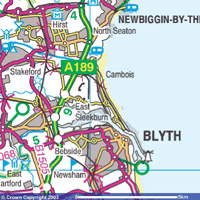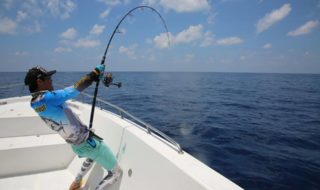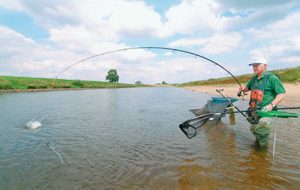 |
THE Cambois shoreline stretches between the
 |
mouth of the River Wansbeck to the mouth of the River Blyth and is known locally as North Blyth. The whole area is a popular fishing venue during the autumn and winter when cod, coalfish and whiting are landed in amazing numbers.
As the waters warm during the summer months, flatfish and bass are the main quarry. The hot water outflow pipe from Blyth Power Station, which used to pump out millions of gallons of hot water on a daily basis, is situated smack bang in the middle of the beach. Since the power station closed a few years ago the bass population has flourished and each season fish to double figures are landed.
Mouth of the River Wansbeck
The marks at the mouth of the river can produce a variety of species ranging from plump flounders often tipping the scales at 2lb to hard-fighting bass, many over the 5lb mark. During the winter, cod, whiting and coalfish are the main quarry with lugworm the top bait. After a spell of rough weather the beach takes on the appearance of the far side of the moon as the sea scours out holes in the sand, forming deep lagoons. As these hollows become exposed by the ebbing tides, they are often full of feeding fish and a cast of 50 yards or less will produce bites. In the summer the estuary is a brilliant competition venue with match anglers landing big bags of flounders and eels to peeler crab and mackerel strip baits.
Valde Burn Pipe
The beach either side of the pipe can produce some excellent bags of cod, usually as the seas calm following a period of stormy weather. The beach forms a series of deep gullies and care should be taken when fishing a flooding tide, especially at night. The bass fishing along this stretch can be outstanding when a light swell is running, with ragworm the top bait and small lures providing good sport. When the seas have been calm for a few days the beach can produce good bags of flatfish with flounder, plaice and dabs the main quarry.
Old Power Station Outflow Pipe
The hot water outflow pipe and power station were de-commissioned more than two years ago. However, the legacy of 40 years of operation, when millions of gallons of hot seawater was pumped out daily, has ensured a resident bass population and flatfish hotspot. The beach either side of the outflow pipe can produce a good variety of species with flounders, plaice, bass and codling to peeler crab and worm baits. During the warmer summer months, bass can be caught on artificial eels, especially when a steady swell is running up the beach.
Behind The Houses
At low tide, an offshore reef called ‘The Rockers’ protects this section of the beach and this mark remains fishable even during very heavy seas. ‘The Rockers’ creates various currents along the shoreline and this turbulence attracts fish to the area, producing a real food larder. During the autumn and winter months, massive catches of cod, coalfish and whiting are had using peeler crab and lugworm baits. Many fish are taken at short range by lobbing the bait just behind the first breaker. The bites can be unbelievable!
North Hole
These low-water rock-edge marks can produce some outstanding catches of cod during the early autumn period when the fish are still feeding in the weed beds. During or just following a southeasterly sea the North Hole is protected from the full force of the storm. Large bags of cod with fish to double figures can be expected. The rocky skeers are interspersed with deep gullies, so great care should be taken when moving from ledge to ledge. If you move along the rock edges as the tide ebbs you literally end up casting back towards the shore. Fresh peeler crab is the best cod bait, followed closely by fresh black lugworm and snake whites.
Briars Haven
The rock edges running out alongside Cambois Pier, which is closed to the general public because of its poor state of repair, seems to go on for ever. The temptation is to try to reach the end rocks, which look as if they should produce the best catches, although often the inner reefs hold the most fish. The golden rule when fishing from this type of mark is always be sure of your route back to shore – and do not take unnecessary risks. On competition days the rock edges are very popular and in past years cod to 20lb have been captured from these marks. Other species will include coalfish, eels and pouting with peeler crab, mussel and lugworm the top baits.
Local Tackle Shops
Sports and Leisure, 8 King Street, Blyth, tel: 01670 365980
CD Tackle, Front Street, Newbiggin-by-the-Sea, tel: 01670 520133





